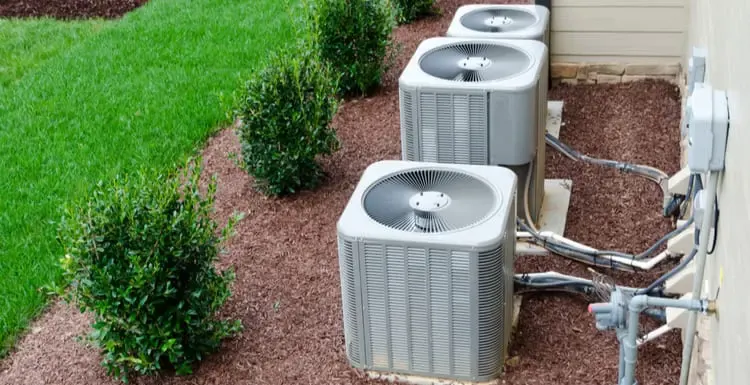Looking for air conditioner maintenance tips?
There are many guides online, but we think ours is one of the most comprehensive around.
Read on to learn what you need to know.
Why Air Conditioner Maintenance?
As every homeowner knows, something always tends to break when you’re least expecting it.
However, a little proactivity can help. Your A/C unit is one of the most expensive appliances in your home, so you should take care of it.
Spending a couple of hours once or twice a year on do-it-yourself maintenance of your home’s air conditioner is a great idea. Here’s how it can help:
- Save on repairs: DIY home air conditioner maintenance can reduce the chances your HVAC system will break down and require expensive repairs.
- Increase efficiency: Spending a few dollars and some DIY time on central air conditioning system maintenance can keep your system operating at peak efficiency. That means lower utility bills.
- Avoid outages: Regularly performing some simple maintenance checks and tasks can keep your A/C from going out. Avoiding just one weekend with no A/C in the middle of a hot spell is plenty of reason to maintain your air conditioning unit.
- Improve indoor air quality: A clean air filter can keep dust and allergy-causing pollen out of the air in your house.
- Increase service life: Replacing a major A/C component, such as a compressor, can easily cost thousands of dollars. Keeping your A/C maintained will increase equipment life and keep it running longer.
If you really want to do home DIY A/C maintenance, locate the manuals that came with your system.
If you can’t find them, contact the manufacturer or look online. Follow their guidelines on when and how to keep the air conditioning system in tip-top shape.
Tools You’ll Need
Professional HVAC technicians arrive with trucks full of costly tools. But you can do your own air conditioner maintenance with a few common household items.
- Buckets and soap
- Bleach or vinegar
- Garden hose
- Butter knife or fin tool
- Leaf rake
- Hedge clippers
- Screw driver
- Level
- Shop Vacuum
- Soft paint brush
- Wrench
You may not need all these common tools. For instance, the ladder will only be needed if your outside unit is on the roof or your A/C filter’s intake is mounted on or near the ceiling.
You can get a fin tool or fin comb for less than $10 at your local home improvement store. It’s handy to straighten bent coil fins. If that’s too much for your budget, you can use a butter knife instead.
You can get a container of coil cleaner. This is used to clean the internal coil. It should cost around $5 at a hardware store or home improvement store. If you want to save money, a soft brush and vacuum will also do the job.
If you’re ready, we’ve made a simple guide to performing a/c maintenance yourself. Read on to learn which steps to take when servicing both the internal and exterior components of your air conditioner.
External Maintenance
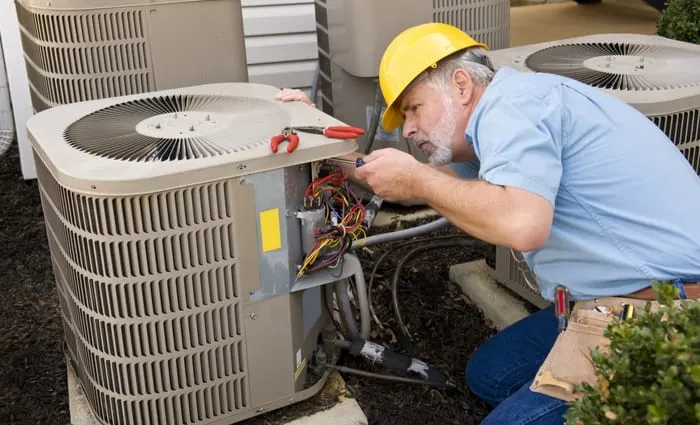
Carolyn Franks/Shutterstock
The hardest-working part of your air conditioning system is the external compressor. It works (often in hot and dirty conditions) to compress A/C fluid so it can be pumped back inside, where it cools as it expands.
This chilled air is then blown through your vents by a blower motor inside the furnace. To do external air conditioner maintenance, follow these steps:
- Turn off the power. Any time you are working on an A/C, the first thing you should do is turn off the power. Flip the switch on the outside condenser to “off.”
- Next, turn off the breaker at the main breaker box. This is important for safety.
- Now use your screwdriver or wrench to remove the grate over the fan. Use the shop vac to vacuum out any leaves or other debris that has collected inside the outdoor unit.
- Use the garden hose to spray the condenser coil. Spray from the inside out. If dirt is stubborn, brush soapy water onto the grate. Let it sit for a few minutes. Now spray the hose from the inside out to rinse.
- Check for bent fins. Gently straighten any bent ones with a fin comb or butter knife. Take care not to damage the tubing.
- Use the hedge clippers to trim back shrubs, limbs, or other plant growth to at least two feet from the unit.
- Rake away any leaves, grass clippings, or other debris from the unit.
- Use the level to see if the unit is level. If it’s settled, lever up the base and shim it so it’s level again.
- Turn the power back on.
It’s important that coil fins be straight and clean to allow for proper air flow. Keeping your coils maintained will save on energy bills and avoid overstressing your compressor.
If your clothes dryer vents externally and this vent is near your condenser, it could be blowing lint into your coils. Check for lint buildup, and if you find it, consider diverting the dryer vent to blow in another direction.
If you are only going to do one A/C maintenance task, check your air filter once a month and replace it when it is dirty. This just takes a few minutes and can save on utility bills, avoid costly repairs, and prolong your unit’s life.
Replace the Furnace Filter
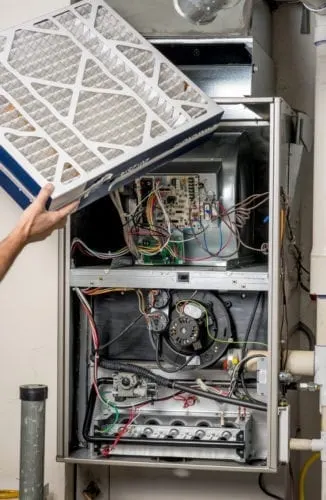
Charles Knowles/Shutterstock
To check and replace your HVAC filter, follow these steps:
- Turn off the power to the air conditioner.
- Locate your filter. It’s usually behind a removable grille near the fan. You may need the screwdriver to remove the grille.
- Remove the filter and replace it with the new one. Make sure you insert it with the arrow pointing toward the fan.
- Replace the grille.
- Turn the power back on.
If you’re using a standard one-inch filter, you may need to change it as often as monthly. If you use a bigger four-inch filter, it may need to be changed only once or twice a year.
Filter life depends on several factors. One of these is how dusty it is around your home and whether you run the fan a lot. The key point, though, is that you should replace it when it looks dirty.
Especially in a large house, there may be two or more air filters. Check ceilings and walls carefully to make sure you have found and checked all filters.
Be aware that HEPA filters capable of filtering out pollen and other allergens can cause your blower to work too hard. If your utility bill goes up after you install an allergy-fighting filter, this may be the cause.
In fact, many HVAC techs I’ve spoken to suggest only using the simple fiberglass filters found at any hardware store. These are the least expensive options, but they are designed to allow adequate airflow into your home.
The HVAC unit is meant to push air through your vents, not act as an allergen filter. If you are concerned about dust and other particles floating around your home, a simple solution is to buy a home air filter.
Clean the Evaporator Coil
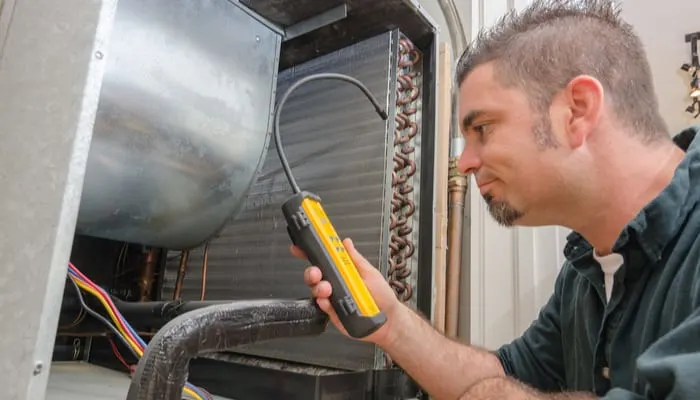
David Spates/Shutterstock
Also consider cleaning the evaporator coil (also known as the a-coil) inside the furnace. This prevents dust from accumulating on the unit, causing damage as a result. The good news is that it’s easy to clean this coil. Here’s how:
- Turn off the power to the air conditioner.
- Locate your inside unit. It may be in a closet or in the attic.
- You may need to pull off some silver duct tape and loosen some screws to gain access to the coil inside the unit.
- Inspect the coil for dirt and dust buildup. If you see any, brush the coil with the soft paint brush to loosen dirt.
- Vacuum the coil to remove the dirt.
- If necessary, spray coil cleaner on the coil to remove any remaining dirt. Let the fluid drip onto the condensation pan under the unit.
- Turn the power back on.
Clear the Condensation Line
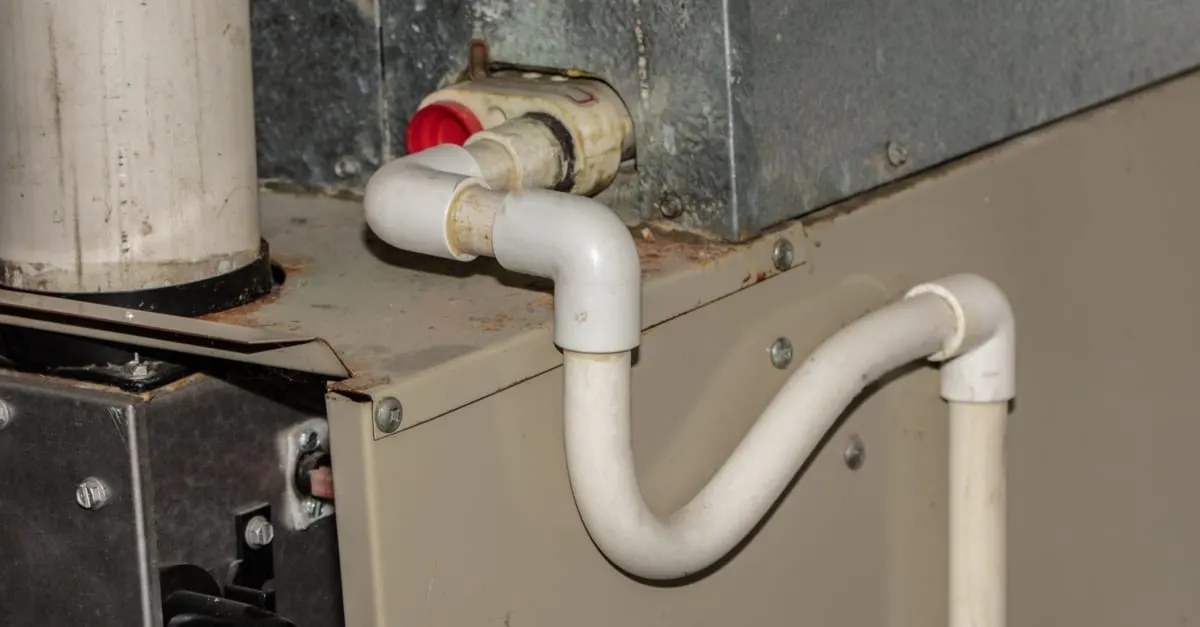
J.A. Dunbar/Shutterstock
Another important part of any air conditioner maintenance plan is to clean the condensation pan and drain line.
Clogged A/C drains can cause damaging water leaks and are one of the most common and easily avoidable A/C problems.
If your drain line gets clogged, water will back up into the condensation pan. Many A/Cs have a float valve that shuts the unit down if the water in the pan gets high enough.
This is often one of the first things an HVAC technician checks on a service call. The fix is simple, and so is preventing the problem.
But the technician will still charge for their visit, even if it takes just a minute to remedy. Luckily, preventing this problem is simple.
Here’s how to keep your condensation pan and drain line clear:
- Cut power to the unit by switching the breaker.
- Inspect the pan. Look for leaks and poor drainage as evidence by pooling water. Also check for algae growth; this can clog the drain.
- If the pan doesn’t drain, unclog the drain line. You may be able to attach a hose to the top of the drain and blow it out. Or you can use the shop vac to suction the end of the drain line. The drain is usually a one-inch PVC pipe that comes out of the cabinet. It typically empties into the yard alongside the house or into a sink or floor drain.
- Restore power to the unit.
You can help avoid clogged drains by placing a pan tablet in the condensation pan. These are available in bags of a dozen or so for $10 or so at hardware stores.
Alternatively, pour a half cup of water with a half cup of bleach or vinegar into the pan twice a year. Either pan tablets or occasional bleach or vinegar treatments will discourage algae from growing and possibly clogging the drain line.
When to Call a Pro
This simple, easy-to-perform air conditioner maintenance goes a long way toward keeping your unit in tip-top shape. It’s also a good idea to schedule a visit from a professional once or twice a year.
A regularly scheduled maintenance call costs only $150 or so. It can easily pay for itself in improved efficiency and reduced repair bills.
Many homeowners have a professional visit their home at the beginning of the heating season and again at the beginning of the cooling season.
A trained technician will perform more advanced diagnostic and maintenance tasks, such as checking for adequate refrigerant levels, compressor pressure, duct leaks, and more. Also, ensure you call a professional if:
- Your A/C won’t turn on at all
- It won’t keep your house at a comfortable temperature
- The unit is short-cycling, turning on and off every few minutes.
- The brass fitting on the outside unit is icy, frozen, or hot to the touch. It should be cold and sweaty.
There’s no need to call a professional for much of this simple air conditioner maintenance. Almost anyone can do most of them with ease.
And you’ll be glad you did when summer heat strikes and you are able to remain comfortably cool inside.

